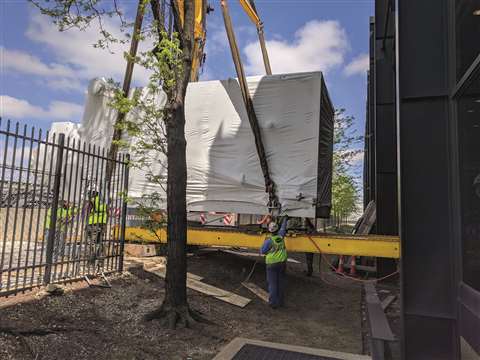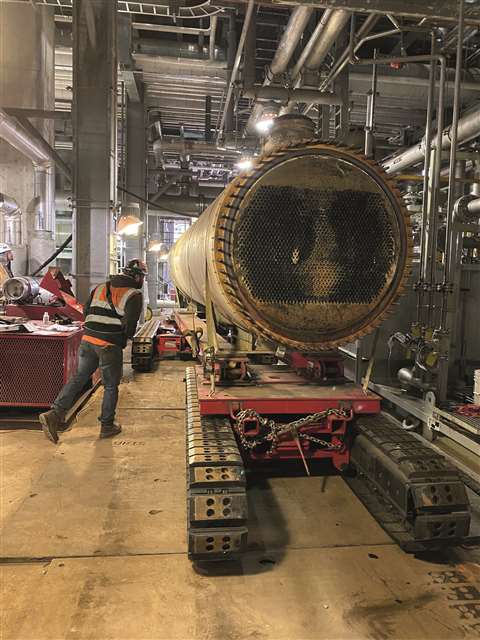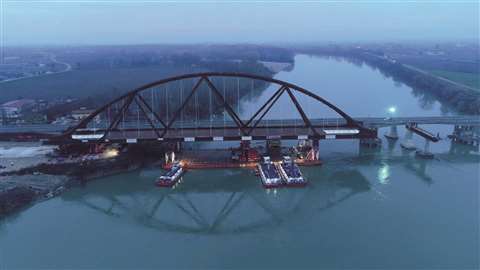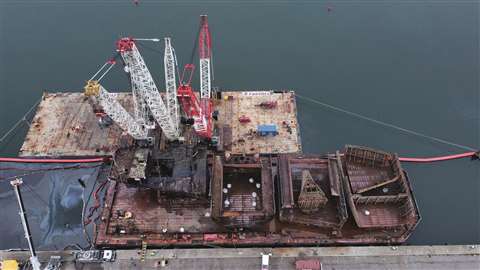SC&RA jobs of the year winners 2022
28 June 2022
The winning projects in the annual SC&RA job of the year competition were announced during the Annual Conference in April in Washington DC, USA. D.Ann Shiffler, editor of ICST sister magazine American Cranes and Transport, reports
Rigging project under US$150,000: Standard Cartage Company
The task was to receive and install hot water generators at an airport in the USA. Work started in 2018 to replace a total of eight Indeck high temperature water (HTW) generators at the site.
 Standard Cartage started work on the project in 2018. (Photo: Standard Cartage)
Standard Cartage started work on the project in 2018. (Photo: Standard Cartage)
Standard Cartage developed a solution that combined a skidding system with air skates and a lightweight “dance floor” to meet the challenge presented. Deep skidding beams were used to span a ditch at the outside perimeter of the H&R plant and provided an area to land the boilers after they had been unloaded by a crane.
The skid system continued inside the building and was used to accommodate a low floor loading limit of 300 pounds per square foot. Skidding beams were used to span weak spots, loading the building instead at the structural beam lines, and spreading the floor load to a sufficient footprint.
Once far inside the building, a “dance floor” was constructed to match the floor elevation with existing equipment pads. Six air-skates were installed and secured to the bottom of a pair of skidding beams.
The beams were then made into a frame by adapting to existing spreader bar inserts, which were already in the toolbox. Lateral forces were controlled by wire-rope, clips, and turnbuckles. Inside the building, the boiler was transferred from the skidding system to the air-skates by applying air to the air-skates and unpinning from the remaining track.
Rigging project between $150,000 and $750,000: Barnhart
Barnhart removed and replaced a horizontal heat exchanger at a fertiliser manufacturing facility in Iowa, USA. Due to its location, replacement posed a unique puzzle. It sat atop two piers that were 6 feet (1.8 metres) off the ground and that could not be removed.
 The horizontal heat exchanger sat on two piers. (Photo: Barnhart)
The horizontal heat exchanger sat on two piers. (Photo: Barnhart)
The exchanger would need to egress the building from the east door. Obstacles included overhead piping and concrete columns. The rigging plan would also need to allow for ducking under a suspended 60 foot (18.3 metre) product line. Barnhart’s engineering group decided on a gantry system with two legs set up at a 45 degree offset.
They would travel in tandem. A slide system could be placed on top, allowing movement from north to south with the exchanger underneath. A swivel connection would allow the exchanger to rotate 90 degrees to line up with the alleyway. Onsite the old vessel was cut free, and the job began. Assembly was complete at the end of one shift, with the replacement beginning at the start of the next.
As the gantries were stroked up, the exchanger cleared the anchor bolts with near perfect dimensions. The dance sequence to the alley was perfect, with gantry travel, header beam travel and the tagline-controlled vessel spin working in chorus towards the south.
A series of cribbing operations stepping down the gantries and lengthening the rigging assured final headroom clearance. Barnhart had assembled two SofTrac carriers in a bolster to bolster configuration.
With their low travel height and manoeuvrability, this system was ideal for shuttling the exchangers inside the plant.
Rigging project between $750,000 and $2 million: Fagioli
Fagioli was involved in the launching operation of a 2,800 tonne bridge section for the new San Benedetto Po bridge in Mantova, Italy. The span was 180 metres long and was lifted by a jack-up system to allow the insertion of self propelled modular transporter (SPMT) under the structure.
The trailers transferred the section onto a dedicated barge provided with towers and other SPMT for perfect alignment with the central piles positioned into the river. Fagioli executed the load out operations in nine main phases. The first was installing the jack-up system.
Next was lifting the bridge by the jack-up system and placing it on an aggregate of 150 axle lines of SPMT. In the third phase the bridge section was transported until the beams were aligned with the temporary towers positioned onto the waiting barge.
The next challenge was to transport the bridge section with the first and third SPMT convoys. Phases five through seven involved the careful repositioning of the bridge section on the SPMT convoys to finally position the bridge span on the towers.
 The span was 180 metres long and was lifted by a jack-up system to allow the insertion of self propelled modular transporter. (Photo: Fagioli)
The span was 180 metres long and was lifted by a jack-up system to allow the insertion of self propelled modular transporter. (Photo: Fagioli)
Phase Eight involved the transport of sections towards the barge and the transfer of load onto the bow and stern towers onto the barge. Finally, it was manoeuvred towards the piles and cap pier using strand jacks and the tugboat and the bridge section was released onto foundations.
Subsequently the barge was removed after the bridge section load transfer had been completed.
Rigging project over $2 million: Fagioli
Fagioli in Italy was contracted for the salvage operation of a wreck in the Mediterranean Sea. The Berkan B was a small ship – something between a small bulk carrier and a handysize bulk carrier.
First Fagioli had to confine the waters surrounding the wreckage with barriers to contain any pollutants. Next, the team needed to cut the wreck into large sections using a special diamond wire cutting machine operated by a team of specialist divers supported by a remotely operated underwater vehicle (ROV).
Fagioli planned to use a 600 tonne capacity crane secured to a barge to lift each section and move them onto a service barge used as a temporary storage area. When the vessel had been cut into sections and the operation plan was approved, Fagioli’s team started the lifting operations.
 Fagioli were also involved in the salvage operation of a wreck in the Mediterranean Sea. (Photo: Fagioli)
Fagioli were also involved in the salvage operation of a wreck in the Mediterranean Sea. (Photo: Fagioli)
The most challenging lift was the removal of the stern, assured to be the heaviest section. Documents supplied to Fagioli said the stern weighed 500 tonnes but, in the end, it actually weighed 800 tonnes.
Fagioli determined the best solution was to use three crawler cranes (600, 650 and 450 tonne capacity) positioned onto the barge for the removal of the stern.
STAY CONNECTED


Receive the information you need when you need it through our world-leading magazines, newsletters and daily briefings.




